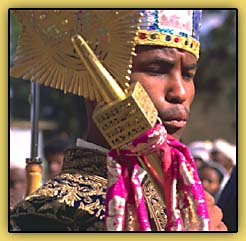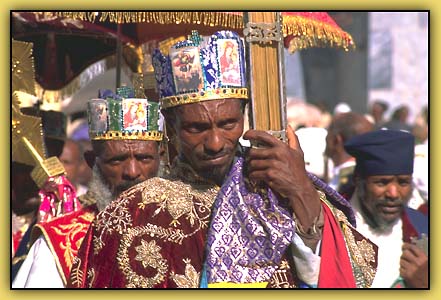�
| �
�
�
�
A great mystery of the Bible�
�
In early Old Testament times the Ark of the Covenant was worshipped by the �
Israelites as the embodiment of God Himself, as the sign and the seal of His �
presence on earth, as the stronghold of His power, and as the instrument of �
His ineffable will.(l) Built to contain the tablets of stone upon which the �
Ten Commandments had been written, it was a wooden chest measuring three feet �
nine inches long by two feet three inches high and wide.(2) It was lined �
inside and out with pure gold and was surmounted by two winged figures of �
cherubim that faced each other across its heavy golden lid.(3) �
�
Biblical and other archaic sources speak of the Ark blazing with fire and �
light, inflicting cancerous tumours and severe burns, levelling mountains, �
stopping rivers, blasting whole armies and laying waste cities. The same �
sources also leave no doubt that it was, for a very long time, the �
cornerstone of the evolving Jewish faith: indeed when King Solomon built the �
First Temple in Jerusalem his sole motive was to create 'an house of rest for �
the Ark of the Covenant of the Lord'.(4) At some unknown date between the �
tenth and the sixth century BC, however, this uniquely precious and puissant �
object vanished from its place in the Holy of Holies of that Temple, vanished �
without song or lamentation in the Scriptures - almost as though it had never �
existed at all. The evidence suggests that it was already long gone when the �
armies of Nebuchadnezzar burned Jerusalem in 587 BC. Certainly it was not in �
the Second Temple which was built over the ruins of the First after the Jews �
had returned from their exile in Babylon in 538 BC. Neither does it seem to �
have been taken as booty by the Babylonians. �
�
Writing in 1987, Richard Elliott Friedman, Professor of Hebrew and �
Comparative Religion at the University of California, expressed a view shared �
by many scholars when he described the disappearance of the sacred relic as �
'one of the great mysteries of the Bible':�
�
 �
There is no report that the Ark was carried away or destroyed or �
hidden. There is not even any comment such as 'And then the Ark disappeared �
and we do not know what happened to it' or 'And no one knows where it is to �
this day'. The most important object in the world, in the biblical view, �
simply ceases to be in the story.'(5)� �
There is no report that the Ark was carried away or destroyed or �
hidden. There is not even any comment such as 'And then the Ark disappeared �
and we do not know what happened to it' or 'And no one knows where it is to �
this day'. The most important object in the world, in the biblical view, �
simply ceases to be in the story.'(5)�
�
�
Indeed so. A close reading of the Old Testament reveals more than two �
hundred separate references to the Ark of the Covenant up until the time �
of Solomon (970-931 BC); after the reign of that wise and splendid king �
it is almost never mentioned again.(6) And this, surely, is the central �
problem, the real historical enigma: not, human nature being what it is, that �
an immensely valuable golden chest should go missing, but - given its supreme �
religious significance - that it should go missing amidst such a deafening, �
improbable silence. Like a black hole in space, or a negative photographic �
image, it is identifiable in the later books of the Old Testament only by �
what it is not - it is, in short, conspicuous only by its absence. �
�
From this it seems reasonable to suggest that some sort of cover-up may �
have taken place - a cover-up devised by priests and scribes to ensure that �
the whereabouts of the sacred relic would remain forever a secret. If so then �
it is a secret that many have tried to penetrate - a secret that has inspired �
several treasure-hunting expeditions (all of which have failed) and also one �
enormously successful Hollywood fantasy, Raiders of the Lost Ark, �
which was first released in the USA and Europe in 1981 with Harrison Ford in �
the starring role as Indiana Jones. �
�
I was living in Kenya at the time and had no opportunity to see the film �
until it finally arrived in Nairobi's cinemas early in 1983. I enjoyed the �
combination of action, adventure and archaeology and I remember thinking what �
a sensation it would be if someone were really to find the Ark. Then, only a �
few months later, I made an extended visit to Ethiopia during which I �
travelled to the north-west of the war-torn province of Tigray. It was there, �
in Axum - the so-called 'sacred city of the Ethiopians' (7) - that I had my �
encounter with the guardian monk reported earlier in this chapter.�
�
 � �
�
�
�
Return to Ethiopia Index�
Initiation: 1986 | �
A great mystery of the Bible | �
1983: a country at war�
Into Axum | �
Palaces, catacombs and obelisks | �
The sanctuary chapel �
�
�
�
| �
| �
 �
�
 �
�
 �
�